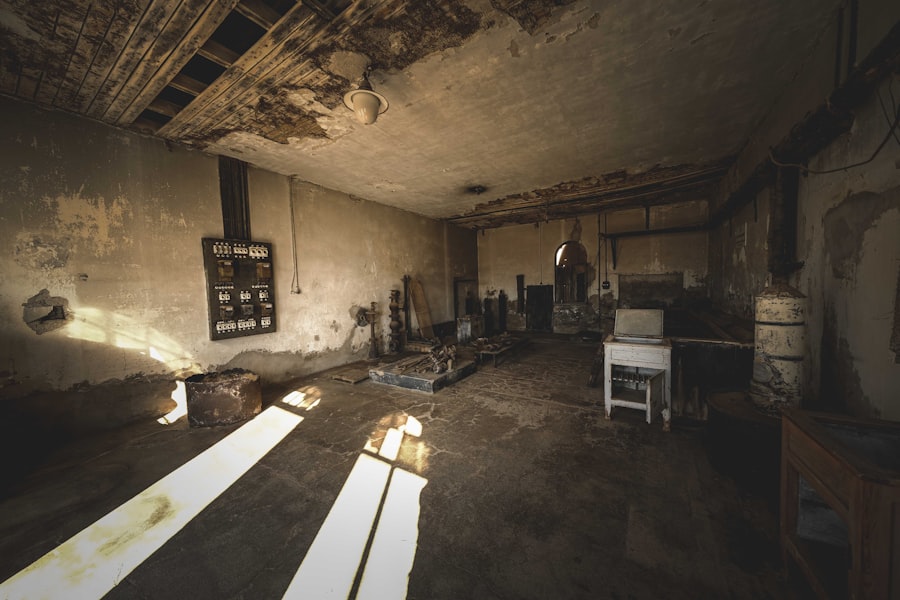In recent years, the food industry has witnessed a significant transformation with the emergence of ghost kitchens. These innovative culinary spaces, designed solely for food preparation and delivery, have revolutionized how restaurants operate. You may have noticed that many popular food delivery apps now feature a plethora of restaurant options that you may not have seen in traditional dining settings.
This shift is largely due to the rise of ghost kitchens, which allow chefs to focus on creating delicious meals without the overhead costs associated with a brick-and-mortar establishment. As you explore your local food scene, you might find that these kitchens are often hidden away in industrial areas, operating under various brand names while sharing the same kitchen space. The concept of ghost kitchens is not entirely new, but it has gained momentum in recent years, particularly during the COVID-19 pandemic.
As dining restrictions forced many restaurants to close their doors to in-person customers, many turned to delivery services as a lifeline. This necessity led to the rapid growth of ghost kitchens, which can operate with minimal staff and lower expenses. You may find it fascinating that these kitchens can cater to multiple brands simultaneously, allowing for a diverse menu without the need for multiple physical locations.
This flexibility has made ghost kitchens an attractive option for both established restaurants looking to expand their reach and new entrepreneurs eager to enter the food industry.
Key Takeaways
- Ghost kitchens have emerged as a response to the growing demand for food delivery and the rise of virtual restaurants.
- Technology has significantly impacted food delivery, making it more efficient and convenient for both restaurants and consumers.
- Ghost kitchens offer benefits such as lower operating costs, increased efficiency, and the ability to test new concepts and menus.
- Virtual restaurants, operating solely through food delivery apps, have become increasingly popular due to the rise of ghost kitchens.
- Data analytics play a crucial role in ghost kitchens, helping to optimize operations, improve customer experience, and make data-driven decisions.
The Impact of Technology on Food Delivery
Technology has played a pivotal role in shaping the landscape of food delivery, and its influence is particularly evident in the rise of ghost kitchens. With the advent of mobile apps and online ordering platforms, you can now access a wide variety of cuisines from the comfort of your home. This convenience has not only changed your dining habits but has also prompted restaurants to adapt their business models to meet your evolving preferences.
Ghost kitchens leverage this technology by streamlining operations and optimizing delivery processes, ensuring that your food arrives hot and fresh. Moreover, advancements in logistics and tracking systems have enhanced the overall delivery experience. You can now track your order in real-time, providing you with peace of mind as you await your meal.
Ghost kitchens utilize these technologies to manage their operations efficiently, allowing them to focus on food quality while minimizing wait times. As you navigate through various food delivery apps, you may notice that many ghost kitchens are able to offer competitive pricing and quick service, making them an appealing choice for busy consumers like yourself.
The Benefits of Ghost Kitchens for Restaurants

For restaurants, ghost kitchens present a myriad of benefits that can significantly enhance their operational efficiency and profitability. One of the most compelling advantages is the reduced overhead costs associated with traditional dining establishments. By eliminating the need for a physical dining space, restaurants can allocate their resources more effectively.
This means that you may enjoy lower prices on your favorite dishes, as restaurants can pass on some of their savings to you.
If you’re a fan of trying new cuisines or unique flavor combinations, you’ll appreciate that chefs can test new concepts and menus in a ghost kitchen setting before committing to a full-scale launch.
This flexibility allows restaurants to respond quickly to changing consumer preferences and trends, ensuring that you always have access to exciting dining options.
The Rise of Virtual Restaurants
| Metrics | Data |
|---|---|
| Number of virtual restaurants | Increasing |
| Percentage of virtual orders | Rising |
| Revenue from virtual restaurants | Growing |
| Customer satisfaction | Positive |
As ghost kitchens continue to gain traction, the concept of virtual restaurants has also emerged as a significant trend within the food industry. Virtual restaurants operate exclusively online, relying on delivery services to reach customers like you. These establishments often create unique brand identities and menus that cater specifically to the tastes and preferences of their target audience.
You might find it intriguing that many virtual restaurants are born from existing ghost kitchens, allowing chefs to diversify their offerings without incurring additional costs. The rise of virtual restaurants has also led to increased competition in the food delivery market. With so many options available at your fingertips, you can explore a wide range of cuisines and dining experiences without ever leaving your home.
This abundance of choices not only satisfies your cravings but also encourages culinary innovation as chefs strive to create standout dishes that capture your attention. As you browse through various delivery apps, you’ll likely encounter an array of virtual restaurant concepts that pique your interest and inspire your next meal.
The Role of Data Analytics in Ghost Kitchens
Data analytics has become an essential tool for ghost kitchens, enabling them to make informed decisions that enhance their operations and improve customer satisfaction. By analyzing consumer behavior and preferences, ghost kitchens can tailor their menus and marketing strategies to better align with what you want. For instance, if data shows that certain dishes are particularly popular among customers in your area, ghost kitchens can prioritize those items, ensuring that you have access to your favorites.
Furthermore, data analytics allows ghost kitchens to optimize their inventory management and reduce food waste. By tracking sales trends and customer feedback, they can adjust their purchasing decisions accordingly. This means that when you place an order, you’re more likely to receive fresh ingredients and well-prepared meals.
The ability to leverage data not only enhances the overall dining experience for you but also contributes to the sustainability efforts within the food industry.
The Influence of Consumer Demand on Ghost Kitchens

Consumer demand plays a crucial role in shaping the success of ghost kitchens. As you navigate through various food delivery platforms, your preferences and choices directly impact which cuisines thrive and which fade away. The rise of health-conscious eating habits, for example, has led many ghost kitchens to offer healthier menu options that cater to your dietary needs.
Moreover, the convenience factor cannot be overstated. As a busy consumer, you likely appreciate the ease of ordering food online rather than cooking at home or dining out.
Ghost kitchens capitalize on this trend by providing quick service and diverse menu options that cater to your lifestyle. Your desire for convenience drives innovation within these kitchens, prompting them to experiment with new flavors and delivery methods that enhance your overall experience.
The Future of Ghost Kitchens in the Food Industry
Looking ahead, the future of ghost kitchens appears promising as they continue to evolve within the food industry. As consumer preferences shift towards convenience and variety, these culinary spaces are well-positioned to meet those demands. You may find that ghost kitchens will increasingly adopt advanced technologies such as artificial intelligence and automation to streamline their operations further.
This could lead to even faster delivery times and improved food quality, enhancing your overall dining experience. Additionally, as sustainability becomes a more pressing concern for consumers like yourself, ghost kitchens may adopt eco-friendly practices in their operations. From sourcing local ingredients to implementing waste reduction strategies, these kitchens have the potential to contribute positively to environmental efforts while still delivering delicious meals to your doorstep.
As you consider your dining choices in the future, you’ll likely be drawn to establishments that prioritize sustainability alongside quality and convenience.
The Challenges and Opportunities of Operating a Ghost Kitchen
While ghost kitchens offer numerous advantages, they also come with their own set of challenges that operators must navigate. One significant hurdle is maintaining consistent quality across multiple brands operating within the same kitchen space. As a consumer, you expect high standards when it comes to food preparation and presentation.
Ghost kitchen operators must ensure that each brand maintains its unique identity while delivering exceptional meals consistently. On the flip side, these challenges present opportunities for innovation and growth within the industry. Operators can experiment with different cuisines and concepts without the constraints of traditional restaurant models.
This flexibility allows them to adapt quickly to changing consumer preferences and market trends. As you explore various food options through delivery apps, you’ll likely encounter exciting new brands and flavors that emerge from this dynamic environment.
The Environmental Impact of Ghost Kitchens
The environmental impact of ghost kitchens is an important consideration as they continue to grow in popularity. On one hand, these kitchens can contribute positively by reducing food waste through efficient inventory management and streamlined operations. By utilizing data analytics to track consumer preferences and sales trends, ghost kitchens can minimize excess inventory and ensure that ingredients are used effectively.
However, there are also concerns regarding packaging waste associated with food delivery services. As a consumer who values sustainability, you may be aware that many ghost kitchens rely on single-use packaging for their deliveries. This trend raises questions about how the industry can balance convenience with environmental responsibility.
Moving forward, it will be essential for ghost kitchens to explore eco-friendly packaging solutions and implement practices that reduce their overall environmental footprint.
The Evolution of Food Delivery Services
The evolution of food delivery services has been marked by rapid advancements in technology and changing consumer behaviors. In recent years, you’ve likely witnessed a shift from traditional phone orders to app-based platforms that offer seamless ordering experiences. This transformation has paved the way for ghost kitchens to thrive as they capitalize on the growing demand for convenient dining options.
As food delivery services continue to evolve, you can expect even more innovations on the horizon. From drone deliveries to automated kitchen technology, the future promises exciting developments that will further enhance your dining experience. Ghost kitchens will play a crucial role in this evolution by adapting their operations to align with emerging trends and technologies.
The Global Expansion of Ghost Kitchens
The global expansion of ghost kitchens is a testament to their growing popularity across diverse markets. As you explore international cuisines through food delivery apps, you’ll likely encounter ghost kitchens operating in various countries around the world. This trend reflects not only changing consumer preferences but also the adaptability of ghost kitchen models in different cultural contexts.
In many regions, entrepreneurs are seizing the opportunity presented by ghost kitchens to introduce unique culinary concepts that cater specifically to local tastes. Whether it’s fusion cuisine or traditional dishes reimagined for delivery, you’ll find an exciting array of options as these kitchens continue to expand globally. As you embrace this culinary diversity, you’ll be contributing to a vibrant food culture that transcends geographical boundaries.
In conclusion, ghost kitchens represent a significant shift in the food industry landscape, driven by technological advancements and changing consumer demands. As you navigate this evolving culinary world, you’ll discover new flavors and experiences that reflect the innovative spirit of ghost kitchens while enjoying the convenience they offer.
Ghost kitchens have revolutionized the food industry by providing a cost-effective and flexible solution for restaurateurs looking to expand their reach without the overhead of a traditional dining establishment. These virtual kitchens operate solely for delivery and takeout, leveraging the growing trend of online food ordering. For those interested in exploring the financial implications and growth potential of such innovative business models, a related article can be found on the How Wealth Grows website. You can read more about the economic impact and investment opportunities associated with ghost kitchens by visiting this article.
WATCH THIS! Delivery Apps Burn Billions, Then Torch Your Wallet — Let’s Expose the Surcharge Circus.
FAQs
What are ghost kitchens?
Ghost kitchens, also known as virtual kitchens or cloud kitchens, are professional food preparation and cooking facilities set up for the preparation of delivery-only meals. These kitchens have no physical storefront and are designed specifically for fulfilling online orders through food delivery apps.
How do ghost kitchens operate?
Ghost kitchens operate by partnering with food delivery platforms such as Uber Eats, DoorDash, or Grubhub to receive and fulfill online orders. They do not have a traditional dine-in or take-out service and focus solely on preparing and delivering meals to customers.
What are the benefits of ghost kitchens?
Ghost kitchens offer several benefits, including lower overhead costs compared to traditional restaurants, the ability to test new concepts and menus without the expense of a physical location, and the flexibility to adapt to changing consumer preferences and demand.
Are ghost kitchens a new concept?
While the concept of ghost kitchens has gained popularity in recent years, the idea of commercial kitchens dedicated to food delivery has been around for some time. However, advancements in technology and the rise of food delivery apps have contributed to the rapid growth of ghost kitchens in the food industry.
Who uses ghost kitchens?
Ghost kitchens are utilized by a variety of food businesses, including established restaurant chains looking to expand their delivery reach, independent chefs and entrepreneurs testing new concepts, and virtual restaurant brands that operate exclusively through delivery apps.
Are ghost kitchens regulated like traditional restaurants?
Regulations for ghost kitchens vary by location, but they are typically subject to the same health and safety standards as traditional restaurants. However, since they do not have a physical storefront, they may be subject to different zoning and licensing requirements.
